|
|
|
 |
|
"Woe to the one who builds
his palace through unrighteousness,
his upper rooms through injustice; who makes his neighbors
work for nothing and does not give them their wages"
JEREMIAH 22:13
|
|
|
 |
|
 |
| |
On the southern outskirts of Jerusalem, overlooking
the “patriarchal highway” to Bethlehem and Hebron
towards the south, and the Valley of Refaim leading
westwards to Philistine territory and the coast,
lies Kibbutz Ramat Rahel.
Nearly a half century ago, Israeli archeologist
Yochanon Aharoni excavated parts of the Tel to find
the walls of a royal citadel and lovely proto-Aoelic
capitals which once decorated the upper story.
On my archeological tours through the Israel Museum,
I would always show the fancy royal capitals and the
window balustrade from the Ramat Rahel dig.
|
|
 |
|
Photo: Gila
Yudkin |
|
These proto-Aoelic capitals once
adorned the king's palace at Ramat Rahel |
| |
The king’s palace was, however, scathingly denounced
by the Prophet Jeremiah (22:13,14): “Woe to
him…who says, ‘I will build myself a spacious house
with large upper rooms,’ and who cuts out windows
for it, paneling it with cedar, and painting it with
vermillion.”
At the beginning of July, I chanced to hear that
after 43 years, the dig was about to resume under
the direction of Dr. Oded Lipschits of Tel Aviv
University. Curious, I drove to the kibbutz,
where I have lunched with nearly every tour group
for the past two decades, to check out the rumor.
|
| |
A bit north of the royal citadel, two youth groups,
armed with picks, shovels and spades, were opening
squares. I met Oded, who enthusiastically
shared his plans for a four season dig, starting in
ten days time. He invited me to participate as
a volunteer and casually asked if I knew anyone who
may be interested in becoming a sponsor of the dig.
A few days later, I awoke abruptly at 4 a.m. with a
thought: “Bill Creasy.” I immediately emailed
the idea and web links about the Ramat Rahel dig to
Bill, with whom I have guided nearly 20 tours over
the past decade. His immediate reaction was to
check out flight availability from L.A. to Tel Aviv.
Once we got Oded’s ok,
Bill was here within a week.
|
|
 |
|
Photo: Gila
Yudkin |
|
Professor Oded Lipschits, director of
the Ramat Rahel dig |
| |
Straight from Ben Gurion Airport, we arrived at
Ramat Rahel just at the beginning of the first week
of the first season’s orientation to hear Oded
declare, “There are some hidden antiquities waiting
for us for 2,800 years.”
By the
light of the full moon, we set out for
the Tel at 5.15 each morning, equipped with
wheelbarrows, picks, shovels, spades, buckets and
gardening gloves. We were a team of 58
volunteers, from Israel to Indonesia, Heidelberg to
Los Angeles, Boston to Basel and North Africa
(Tunisia) to North Carolina, all eager to tackle the
mysteries of the Tel and unearth artifacts from the
Iron Age/Israelite period. We were Jewish,
Christian and Moslem, all interested in the Bible
and archeology. |
| |
|
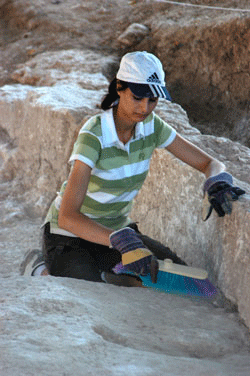 |
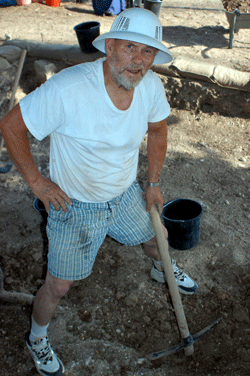 |
|
Photo: Bill Creasy |
Photo: Bill Creasy |
|
From North Africa: Amira
from Tunisia |
To North Carolina: Louis
from Charlotte |
| |
In Area A where I dug, our ages ranged from 19 to
70. Among us, in descending order of age,
there was a retired high school science teacher, a
mail carrier, a retired UCLA professor (that’s
Bill), an Israeli city engineer who was a
grandmother, a biology teacher, a Jerusalemite tour
guide (that’s me!), a professor of theology from the
University of Heidelberg in Germany who brought
undergraduates, masters and doctoral students, a
Reform Calvinist Pastor, a Tel Aviv University Iron
Age pottery expert (who had four daughters), a
volunteer from Harvard’s Semitic Museum, and two
college sophomores – one from Mount Holyoke and one
from Boston College.
|
|
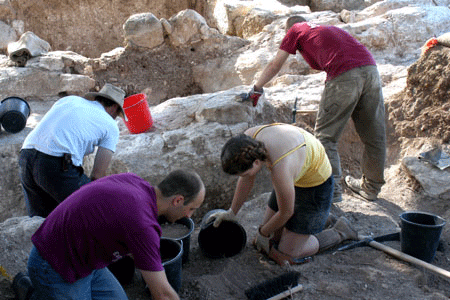 |
|
Photo: Bill
Creasy |
|
Shahaf, Karsten, Gesina and Chuck
excavating in Area A |
| |
Nirit, our area supervisor, 32, has a degree in
architecture and practical experience in interior
design. After working on a number of digs, she
decided she wanted to be an archeologist “when she
grew up.” Shahaf, her co-supervisor, 29, is
majoring in the Chalcolithic period (the
Stone-Copper Age) of about 4,000 B.C., way before
the time of Abraham.
Everyone found his or her niche, according to
disposition and physical prowess. Shahaf and
70-year-old Louis were the expert pick-axers – even
before breakfast.
Bill was a fleet-footed wheel-barrow runner and
bucket collector. I alternated between the
shovel squad and the bucket brigade.
|
What did we find? Frankly, not much. But
the intuition that there is a lot buried, waiting to
be discovered, sustained us. “When we found a
handle with the imprint of the potter,” said Sabina,
a student of theology, “I felt history with my own
hands and I felt the person who manufactured it.”
|
|
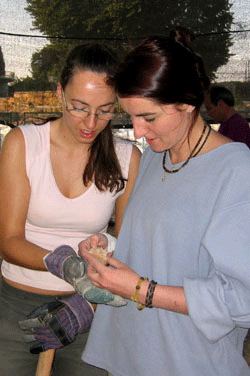 |
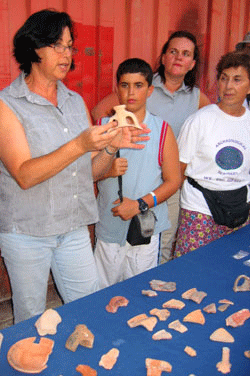 |
|
Photo: Gila
Yudkin |
Photo: Gila
Yudkin |
|
Verena (left) & Sabina inspecting
a handle |
Left, Liora, our pottery expert |
| |
| |
| It was
exciting to watch a former looter who has
become a key member of the Antiquities
Department locate Iron Age artifacts with a
sophisticated metal detector. In our area he
found parts of two rings – one bronze and
one iron. In other areas he found
coins. |
| |
|
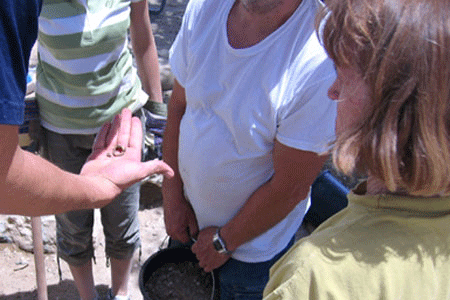 |
|
Photo:
Gila Yudkin |
|
Iron Age/Israelite period
artifacts found with a metal detector |
| |
| When I
returned to visit the dig the following
week, volunteers in Area B had found a seal
on a jar handle with an Iron Age
inscription, “Ahaziayahu / Tanhum.” He
may have been a minister serving one of the
Judean kings in the time of Isaiah or
Jeremiah. His inscribed seal has been
found also at Lachish, Beth Shemesh and Tel
en-Nasbeh (Samuel the Prophet’s Mitzpeh).
Who knows what is still hidden in the soil,
just waiting to be unearthed by eager Bible
students of all ages. |
| |
|
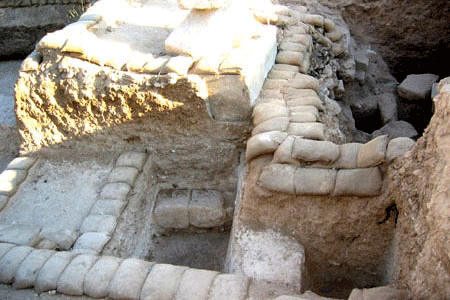 |
|
Photo:
Gila Yudkin |
|
Part of a water system
with 4 pools and a tunnel uncovered in Area
C |
| |
If this dig
appeals to you, and you are available for at
least one week – Sunday through Friday,
during the month of August 2006, you may
want to consider becoming a volunteer.
Age does not matter – what counts is
physical stamina, curiosity, motivation and
a highly developed sense of adventure.
If you are planning a pilgrimage this year,
let me know when we lunch at Ramat Rahel if
you’d like to visit the dig and hear the
story from a first person perspective.
The Royal Citadel with its magnificent
capitals is also a perfect place to contrast
the intrigues and excesses of the Judean
kings, with Jeremiah’s demands for social
justice and accountability.
|
|
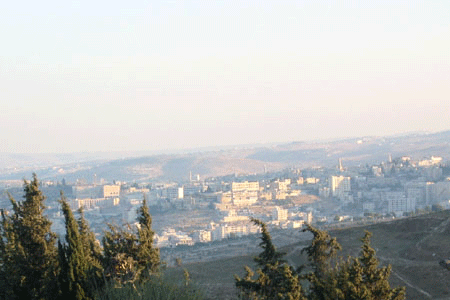 |
|
Photo:
Gila Yudkin |
|
View of Bethlehem from Tel
Ramat Rahel |
| |
|
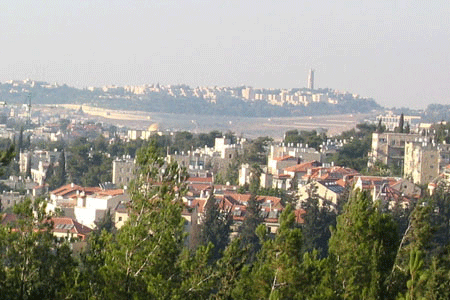 |
|
Photo:
Gila Yudkin |
|
View of Jerusalem from Tel
Ramat Rahel |
|
Note the Dome of the Rock
in the middle, a bit to the left |
| |
| Postscript
When I told my good friend Bracha that I had
dug at Ramat Rahel, she excitedly told me
that she and her high school class had
excavated there as volunteers back in 1963.
At the time, Ramat Rahel was right on the
border with Jordan. I asked her what
she remembered after 40 years. Bracha
wrote,
“When I met with some of my high school
girlfriends and asked them about the dig at
Ramat Rahel, everyone had memories.
Mainly we remembered the director, Yohanon
Aharoni, thin, bespectacled and very quiet,
red-haired Meir Ben Dov [who later dug at
the Ophel, outside the Temple Mount], and
Yigal Shiloh, [director of the dig at the
City of David], who was quite conceited.
What we particularly remember is that they
taught us to work with very small tools and
brushes in order to carefully expose and not
break the objects. We remember racing
with the big black rubber buckets. We
also remember the Jordanian Legionnaires [on
the other side of the border] who would make
catcalls and that we would answer back.
“We were 16 years old and at night we slept
in Jerusalem’s Shneller army base. We
were in a paramilitary framework. The
ideology back then was that high school
students need to prepare for army service,
so every week we had a one-hour lesson in
topography, navigation, how to survive
outside, camping skills, and even fighting
with big sticks. It was as if the
British hadn’t left the country yet and we
had to be ready to fight them from the
underground! Part of it was also a
Zionist indoctrination – our connection with
the Land. And here the archeological
excavation comes into the picture. We
were raised knowing that archeology
documented the Bible.
“We all agreed that the dig was fun and
since then we’ve been interested in
archeology, some more, some less, and it’s
more than forty years afterwards! We
all remember this experience as truly
significant.” |
| |
|
12 MOST
POPULAR ARTICLES this month |
| |
|
More Archeology:
|
|
|
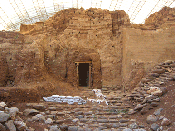 |
 |
 |
|
Dan / Mud-brick gate
|
Hazor / the royal
archive? |
Hippos / Decapolis
city |
|
|
|
|
 |
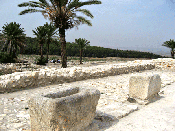 |
 |
|
Herodion / Herod's
Tomb |
Megiddo / Solomon's
Stables |
Beth Shean /
Scythopolis |
|
|
|
|
The Ramat Rahel Archeology Team led by
Professor Oded Lipschits will be excavating
at Tel Azekah starting 2012. Tel
Azekah hasn't been touched by the
archeologist's spade in over a century.
Read about the site in "Let's
scan David and Goliath's battlefield from
the Philistine camp at Azekah." |
|
|
|
Gila Yudkin, who
calls herself a Connecticut-born Yankee
living now in King David's Court, has been
guiding since 1978. This is her second
dig. More than two decades ago she was a
volunteer at Yigal Shilo's City of David
dig. Gila thrives on showing veteran tour leaders
new, authentic, biblical sites. Give her an
opportunity and your sermons will be
enriched and your colleagues envious.... |
| |
|
Copyright 2005 Gila Yudkin. Permission
needed for any reuse. |
|
|
|
GILA
YUDKIN
•
TCHERNIKOVSKI
64A
•
JERUSALEM
•
ISRAEL
gila@itsgila.com
HOME
•
BOOK
GILA
•
TIPS
FOR TOURS •
ABOUT GILA
|
|

